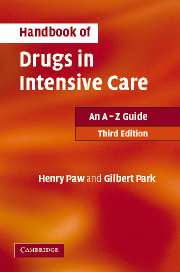Book contents
- Frontmatter
- Contents
- Introduction
- How to use this book
- Abbreviations
- Acknowledgements
- DRUGS: An A-Z Guide
- SHORT NOTES
- APPENDICES
- Appendix A Creatinine clearance
- Appendix B Weight conversion (stones/lb to kg)
- Appendix C BMI calculator
- Appendix D Lean body weight charts
- Appendix E Infusion rate/dose calculation
- Appendix F Drug compatibility chart
- Appendix G Omeprazole administration record
- Appendix H Drotrecogin prescribing criteria
- Appendix I Drotrecogin administration
- Appendix J Drotrecogin administration record
- DRUG INDEX
- Plate section
Appendix I - Drotrecogin administration
Published online by Cambridge University Press: 06 December 2010
- Frontmatter
- Contents
- Introduction
- How to use this book
- Abbreviations
- Acknowledgements
- DRUGS: An A-Z Guide
- SHORT NOTES
- APPENDICES
- Appendix A Creatinine clearance
- Appendix B Weight conversion (stones/lb to kg)
- Appendix C BMI calculator
- Appendix D Lean body weight charts
- Appendix E Infusion rate/dose calculation
- Appendix F Drug compatibility chart
- Appendix G Omeprazole administration record
- Appendix H Drotrecogin prescribing criteria
- Appendix I Drotrecogin administration
- Appendix J Drotrecogin administration record
- DRUG INDEX
- Plate section
Summary
ADMINISTRATION OF DROTRECOGIN ALFA (activated)
Drotrecogin alfa (activated) (Activated Protein C, Xigris™) is a novel drug with anti-inflammatory, anticoagulant and pro-fibrinolytic properties. It has been shown to reduce mortality in septic patients, particularly in patients with multi-organ failure (defined by NICE as 2 or more major organs) when added to best standard care.
It is a very expensive drug and the Prescribing Criteria Checklist must be signed by the ICU Consultant to ensure the patient is eligible to receive drotrecogin alfa (activated) before the drug is made up and administered.
5 mg vial = £152 Treatment for an 80 kg patient will cost >£6000.
Dosage
All patients should receive drotrecogin alfa (activated) at a dose of 24 microgram/kg/hour (use actual body weight) for up to 96 hours (4 days) by intravenous infusion.
If the infusion is interrupted for any reason, Xigris should be restarted at the 24 microgram/kg/hour infusion rate and continued to complete the full recommended 96 hours of dosing administration.
No dosage adjustment is required in acute renal or hepatic failure.
Prescription
Should state: Drotrecogin alfa (activated) 24 microgram/kg/hour for 96 hours xx kg
Preparation and Administration
Drotrecogin alfa (activated) vials must be kept in the fridge
Once reconstituted drotrecogin alfa (activated) is stable for up to 14 hours at room temperature so infusions must not run for longer than this
Giving sets should be labelled with the time and date when the infusion was first started and changed every 48 hours
[…]
- Type
- Chapter
- Information
- Handbook of Drugs in Intensive CareAn A - Z Guide, pp. 259 - 261Publisher: Cambridge University PressPrint publication year: 2007



